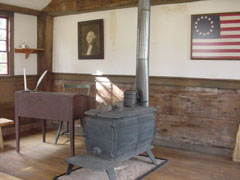Keeney Schoolhouse
 Public schools in colonial Connecticut were operated by the Colony's official, established church, which we now call
"Congregational." The legal institution which managed them was the ecclesiastical society. Qualified voters who belonged to
the official church were members of this society.
Public schools in colonial Connecticut were operated by the Colony's official, established church, which we now call
"Congregational." The legal institution which managed them was the ecclesiastical society. Qualified voters who belonged to
the official church were members of this society.
In 1694, the General Court of the Connecticut Colony chartered an ecclesiastical society in the part of Hartford lying east of the "Great River," consisting of East Hartford and the area called the Five Miles, which later became Orford Parish and still later the Town of Manchester.
In 1745, that Society gave the people in the Hop Brook section, Manchester's first settlement, the right to conduct a school. In 1751, the Society authorized the erection of five schools in the Five Miles, all to be built without cost to the Society. The Society, however, would provide money for operating them.
There is little documentation about the schools erected under this grant. The story is that residents of the Hop Brook area built theirs in one day, using lumber measured and cut in anticipation of the grant. Probably the other four were built shortly thereafter.
Our one-room schoolhouse was originally built on Keeney Street about 1751. We are not certain when it ceased to be used as a school, was sold, and converted to a farm building.
In March 1975, the Town's Bicentennial Committee voted to restore the building and to use a site on Cheney Homestead grounds. The Manchester Historical Society agreed to furnish and equip the building.
By 1975, however, the building had deteriorated so badly that it was not possible to restore it. A replica would have to be built. Volunteer workers dismantled the old structure, saving every usable piece of lumber. Fortunately, in the usable material were a few of the plank joists, shaped by hand to a graceful curve. Fastened to these were laths holding the curved plaster ceiling. Curved ceilings were not unusual in larger buildings of the 18th century, but few rural schoolhouses had them. New joists were cut to make the new ceiling.
The old building's framing showed that a fireplace was originally used for heat. Woodburning stoves had replaced fireplaces in many old schools and it was decided to use such a stove in this replica. The furnishings are antiques and reproductions of the types which might have been found in the old schoolhouse.
The very small size of the classroom may surprise many visitors. The small size is accounted for by the fact that travel was very difficult in early Connecticut. Roads were incredibly bad. Bridges were rarities. It was impossible for small children to walk great distances, particularly in the snow of winter and the mud of spring. With the large families of the old days, a village of only a few houses or a small area of scattered farms required its own school.
All labor on this replica was done by unpaid volunteers*, whose service is here gratefully acknowledged. Many gifts of materials, furniture, books and equipment have assisted in the work. One special donation was a remarkable achievement -- the pupils of the modern Keeney Elementary School raised $1,821 for furnishing and equipping this replica of the first school in their area.
The Keeney Schoolhouse, at 106 Hartford Road, Manchester, Connecticut, is generally open at the same time as the Cheney Homestead, the second Sunday of the month from 1 to 4, and by appointment and for special events. Donations are welcome. Phone 860-647-9983 for more information about tours.
*Volunteers Charles Genovese (1937-2013) and Doug Welch, who were both town firemen at the time, are pictured at right working on the schoolhouse. Click the photo for a larger image.
